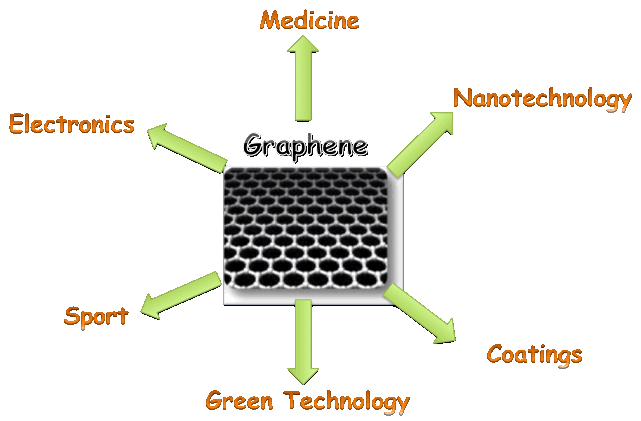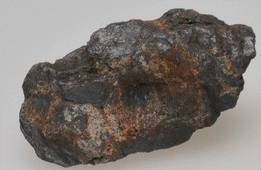
GRAPHENE APPLICATIONS

The interest about the properties of graphene, in the scientific and technological fields, depends on the following aspects of this material:
graphene is a "single layer of graphite" and "graphite" is a material based on carbon;
 Graphite
block
Graphite
block
in the structure of graphene, the electrons, that are bound weakly to the carbon atoms, make the material similar to a superconductor with low energy dispersion.
LOOK AT THIS PRESENTATION: Graphene
This section explains the principal applications of graphene in different fields related to Science and Technology:
|
FIELD |
APPLICATIONS |
|
NANO-ELECTRONICS |
Because of its extraordinary electrical properties, graphene is considered a perfect candidate in applications related to the field of quantum computers; these computers are super-fast and are smaller than the computers used today. The researchers have already realized graphene transistors and simple circuits, capable of operating at very high frequencies, amounting to hundreds of GHz. In particular, in 2010, a research group of IBM succeeded in realizing a transistor made of graphene, with a maximum operating frequency of 100 GHz and with a gate length of 240 nm. Also in 2010 UCLA (University of California, Los Angeles) reached the record speed of 300 GHz for a transistor, in a test with graphene. In 2011, still IBM created a transistor made of graphene, with a frequency of 155 GHz and with a gate length of 40 nm. It is important to note that the speed of a transistor is typically assessed on the basis of the switching frequency; a transistor that works in on/off switching is like a switch, so that when closed it conducts, while when open it does not conduct.
|
|
ELECTRONICS |
definitely unrealizable with a technology based on silicon. Silicon, currently used in Electronics, is a crystalline material, fragile and not suitable in applications where flexibility is required. In the era of graphene, namely “the era of the two-dimensional materials”, the electronic devices “wearable” will fit perfectly into our body. The mobile phones, for example, could be worn as bracelets and you might bend them depending on the need.
Several electronics companies like IBM, Samsung, Sandisk, Xerox, Nokia, are competing through the creation of many patents.
From a long time, the electronics companies have looked for an alternative material to ITO, because of the high cost of indium. Carbon nanotubes have been taken into account with little success; in fact, small defects are formed in visible areas, called "dead pixels”, if they are used in a display. In this context, an important step has been done, thanks to a group of Korean and Japanese scientists, which belong to the team of Byung Hee Hong and Jong-Hyun Ahn at the Sungkyunkwan University in Seoul; they have produced graphene films using the chemical vapor deposition on a flexible copper substrate. The graphene films have rectangular shape with diagonal of 76 cm and electrical resistance higher than the resistance of commercially available transparent electrodes made of ITO. One graphene film allows the passage of about 90% of the light, therefore it has a good transparency. The team has used these graphene films as electrodes in a touch-screen panel; this kind of touch-screen has proved to have better performance than those with ITO electrodes. The team has observed also a resistance to the stretching more than doubled, compared to the resistance of an ITO electrode. The results about the production of graphene films for transparent electrodes have been published in the “Nature Nanotechnology” journal.
These graphene-based super-capacitors have a specific energy density of 85,6 Wh/kg at ambient temperature and of 136 Wh/kg at 80°C, practically similar to that of nickel-metal hybrid batteries, but with the advantage that, the graphene super-capacitors can be reused an indefinite number of times and can be loaded and unloaded very quickly. |
|
VIDEOCOMMUNICATIONS |
The world of video communications will see the graphene as protagonist in advanced applications, such as:
|
|
BUILDING FIELD |
The use of graphene regards projects based on new types of "intelligent" windows, capable to become dark on command or be used as photovoltaic devices for the production of electricity from sunlight. |
|
GREEN TECHNOLOGY |
Graphene is a resistant, and at the same time, lightweight material; it has proved to be suitable in:
|
|
AUTOMOTIVE FIELD and AEROSPACE FIELD |
The
carbon fiber that is currently used in the automotive
|
|
SPORT |
Graphene has been already applied in the construction of sophisticated tennis-rackets:
The graphene tennis-racket was used successfully, for the first time, by Novak Djokovic and Maria Sharapova at the Australian Open, 2013 edition. Look at this video - Graphene: Composite Materials |
|
BIOMEDICAL FIELD |
The graphene oxide has shown bactericidal properties and it may also be used in products for the hygiene and for the preservation of foods. |
|
MEDICINE |
|
Some applications of this extraordinary material have been presented at the "Mobile World Congress 2016" in Barcelona.
Unfortunately,
at the time, the commercial use of this material comes up against
prohibitive
economic logic.
In fact, the production of graphene on a large scale is still an
expensive process. The cost to produce one kilogram of graphene is
amounting to tens of thousands of euros (approximately 35,000 euros)
 .
The
idea that
graphene
can replace silicon in the future processors
remains,
for now, a
dream and
it is a challenge
in Electronics field.
.
The
idea that
graphene
can replace silicon in the future processors
remains,
for now, a
dream and
it is a challenge
in Electronics field.
Then we have to stay ready to a new industrial revolution, in which everything will be produced with graphene, already considered “the plastic of the third millennium”.
|
TO FIND OUT MORE ABOUT GRAFHENE, LOOK AT THESE VIDEOS: |
|
READ MORE: |